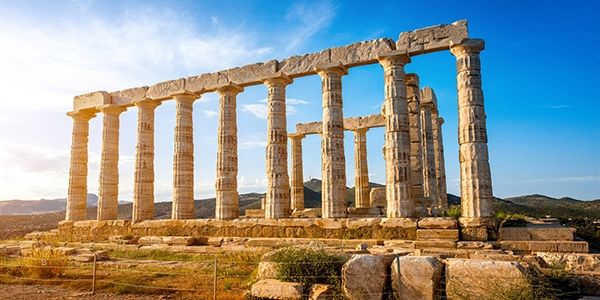
Project Management Lessons From Greek Mythology
For those of you who have attained a CAPM, PMP or other project management credential, you likely learned about the Delphi method while studying for the exam.
Delphi provides teams with an approach to leveraging the knowledge of a group of stakeholders to make a decision while minimizing impacts from bias or personality. The etymology of the term is the Oracle of Delphi who was a legendary soothsayer in the ancient world that lived in Greece. She was consulted by visitors on a variety of topics. In project management, Delphi method can be used to develop estimates which are a prediction of future performance.
Related Article: The Change Control Myth
But this isn’t the only link we can draw between project management and Greek mythology!
Cerberus
Cerberus was a large, multi-headed dog who guarded the gates of Hades (the underworld) and was responsible for preventing the dead from escaping. Heracles (often called Hercules) is famous for having captured this hound as one of his twelve labors. In the myth, Heracles was challenged to capture Cerberus without using weapons – he did so by wrestling the hound and squeezing its head until it submitted.
Think about the last long, arduous project you were on. Didn’t it feel like you were in hell? Cerberus could remind you of the multiple gatekeepers you need to wrangle before your team can be released from the project.
Hydra
While on the topic of multi-headed creatures, let’s not forget about the Hydra. Even though it bears the same name as one of the Marvel Universe’s evil organizations, the Lernaean Hydra was a monster with the remarkable regenerative property of being able to regrow one of its heads after being chopped off. Heracles managed to slay this beast by cutting off each head and cauterizing the neck stumps before they could regenerate.
Ever been on one of those projects where it felt like issues were proliferating like cockroaches in a dirty restaurant? For every issue your team resolves another two emerge. This can happen if we are resolving the symptoms (the heads) instead of focusing on identifying and resolving the root causes.
Cleaning the Augean stables
Yet another of Heracles labors was to clean the stables of Augeas. A huge number of immortal cattle were housed in the stables which meant they had never been cleaned. Rather than use his remarkable strength to clean out the filth, Heracles diverted two rivers and let nature do the hard work.
Sometimes we are faced with a project task or issue which looks like it will require a ridiculous amount of effort to accomplish. Rather than rushing headlong into the fray, savvy teams will step back and come up with a more thoughtful approach.
The Lotus-eaters
While attempting to return home to Ithaca, Odysseus and his men encountered the land of the Lotus-eaters who were extremely lethargic and apathetic due to frequent consumption of lotus fruits and flowers. Three of Odysseus’s men ate lotus products and became lethargic and unwilling to resume their journey home. Odysseus was forced to resort to tying up these affected men and forcibly bringing them back on board his ship.
On long projects, the team can sometimes lose sight of the expected business outcomes. They can get distracted with completing documents or other by-products of the delivery process or be so focused on the triple constraint that they miss changes in the underlying rationale or requirements for the project. A smart project manager will recognize this situation so that they can redirect their team’s efforts in a timely manner.
The Minotaur
You probably know that the Minotaur was a half man, half bull monster but what you might not remember is that it lived in a challenging maze knows as the Labyrinth. When Theseus went to slay the Minotaur, he brought a ball of thread with him. To avoid the risk of getting lost in the Labyrinth, as he entered the maze, he tied one end of the ball of thread to the door.
Risk management is frequently given lip service by project teams, but this can cause them to lose their way. It might not take a lot of effort to tackle key risks early in the life of the project, but the longer the team waits to do so, the greater the probability or impacts of realization.
The Flight of Icarus
Icarus is famous for his failed attempt to escape Crete using wings which his father, Daedalus, had made from wax and feathers. His father warned him not to fly too high or too close to the sun but he ignored this warning and fell into the sea after the sun melted the wax.
Stretch objectives provide an opportunity to be creative and challenge themselves, but the team has to understand their constraints and limitations to avoid a spectacular failure.
Mythology does more than provide literary entertainment; it also provides practical lessons to improve project performance!
“Myth is much more important and true than history. History is just journalism and you know how reliable that is.” ― Joseph Campbell
Black Runtz Strain for sale
… [Trackback]
[…] Read More Info here to that Topic: projecttimes.com/articles/project-management-lessons-from-greek-mythology/ […]
magic mushrooms grow kits for sale online
… [Trackback]
[…] Read More Information here on that Topic: projecttimes.com/articles/project-management-lessons-from-greek-mythology/ […]
เครื่องกรองน้ำโคเวย์
… [Trackback]
[…] Read More on that Topic: projecttimes.com/articles/project-management-lessons-from-greek-mythology/ […]
พรมรถยนต์
… [Trackback]
[…] Find More Info here to that Topic: projecttimes.com/articles/project-management-lessons-from-greek-mythology/ […]